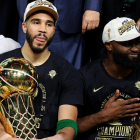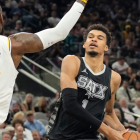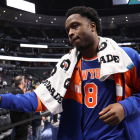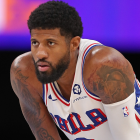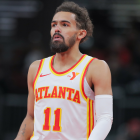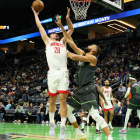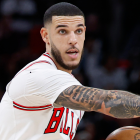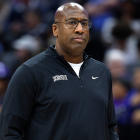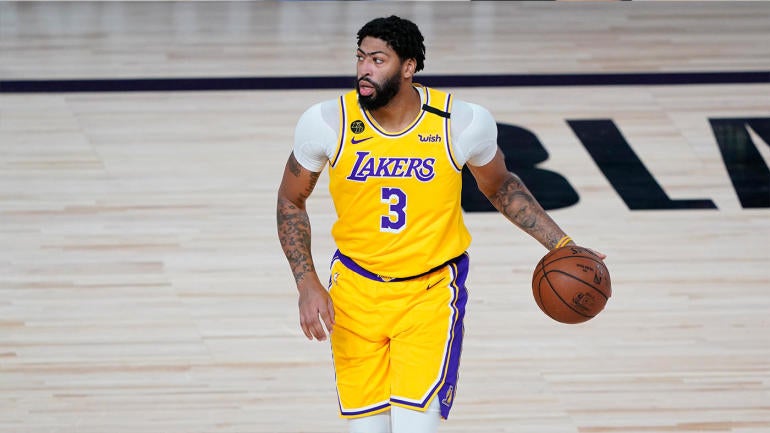
Anthony Davis doesn't like playing the five. We know this because he literally said "I don't really like playing the five" at his introductory press conference with the Lakers in July, and by planting his flag so early, he managed to dictate both his team's identity and his own. Yes, the Lakers have done everything to accommodate him in his first season. They signed Dwight Howard for that express purpose. JaVale McGee, despite a disastrous -23.8 net rating at the Disney bubble, continues to start at center specifically so that Davis doesn't have to. The problems have as much to do with what Davis chooses to do as what he avoids doing. Davis dislikes playing center so much that he doesn't even really play center when he's playing center.
Davis played 40 percent of his minutes at the five during the regular season, according to basketball-reference, and jumped above 50 percent in Tuesday's 100-93 Game 1 loss to the Portland Trail Blazers as he spent around 20 of his 39 minutes on the floor at center. You just wouldn't know it by some of the shots he was taking. While easy points at the basket were there for the taking against a Portland defense that has been absolutely dreadful in the bubble, Davis decided to set up shop behind the 3-point line.
Attempts like those have been all too common. Davis, maybe the most dangerous finisher in basketball, has lived on the perimeter to a startling degree this season. Sharing the floor with another big man only exacerbates the problem by giving him a license to take ill-advised mid-range jumpers early in the shot-clock. What else is he supposed to do when the paint is clogged?
The problem is baked so deeply into the Laker offense that they're coming up with these shots intentionally. The first play of any game is the easiest to script because so few variables exist to complicate it. Plenty of teams use it to help their big man feel engaged with a quick post touch. The Lakers ran a cross-screen to free their likely First-Team All-NBA center up for ... a baseline jumper.
There's a theoretical argument to be made about the brave new world we're living in. Certain big men shoot from distance all of the time. Nobody should bat an eye when LaMarcus Aldridge pulls up from 18 feet because most of the time, those shots are going in. The problem isn't necessarily that Davis is taking jumpers. The problem is that he's bad at it.
Davis shot 2 of 15 from outside of the restricted area Tuesday. The percentage is extreme, but only a bit. Davis takes the 13th most mid-range shots per game in the NBA, but made only 34.9 percent of them. Every player who took more of those shots hit at least five percentage points more than him. Carmelo Anthony, whom the Lakers declined to sign for the minimum and faced on Tuesday, makes 39.9 percent. This isn't an outlier.
| SEASON | Mid-Range FGA per game | Mid-Range FG % |
|---|---|---|
2019-20 | 4.1 | 34.9 |
2018-19 | 4.2 | 35.5 |
2017-18 | 5.4 | 36.4 |
He doesn't do himself any favors with the sort of shots he takes. Davis has a maddening tendency to fade away unnecessarily on mid-range jumpers, particularly turnaround looks that the defender is happy to surrender.
The 3-point shooting is a newer addition, as he's been encouraged to fire away. Davis attempted a career-high 218 this season, but made only a pedestrian 33 percent of them. Earlier in the season, Frank Vogel pushed him to attempt five per game under the logic that it would open up the court for other kinds of shots. It largely hasn't, and that extends beyond the underwhelming shooting itself. Defenders have been falling for Joel Embiid's hardly picturesque pump-fake for years, but Davis doesn't really have one. The closest he'll come is an awkward, loping step toward the basket that robs him of his balance.
Defenses don't fall for that because of how badly they want Davis shooting from behind the arc. That was evident on one play last night in particular. Damian Lillard instinctively flashes into a closeout on Davis before he realizes who's shooting. He then backs off, lets Davis take his step, and trusts him to miss the shot.
A couple of vanity 3s per game from a big aren't an issue in a vacuum. They become problematic when they detract from what that big man actually does well, and that has been Davis' shot-profile in a nutshell. He hasn't taken so few shots in the restricted area per game since the 2016-17 season, and that decline lines up perfectly with his rising 3-point totals. Davis is taking 0.9 fewer restricted area shots per game this season than he did last, but 0.9 more 3-pointers per game. He has essentially replaced a layup with a jumper every game.
And while Davis' jumpers are statistically bad shots, his layups are empirically great ones. He made six of his nine attempts in the restricted area against Portland, and hit 73.5 percent of such attempts during the season. Only Giannis Antetokounmpo, John Collins and Rudy Gobert were better at his volume, and none of them had to share minutes with McGee or Howard. The LeBron-Davis pick-and-roll was one of the few things that worked for the Lakers in Game 1.
It's common sense. Getting an athlete like Davis running downhill is usually going to lead to a good shot. He's perhaps the greatest lob finisher in NBA history. But when it counted down the stretch, the Lakers didn't take advantage of it. Davis set halfhearted screens, and he left points on the board by not diving hard to the basket off of those screens or popping behind the arc as an alternative.
Post-ups are inherently inefficient shots, but make sense in the right matchups. Davis was guarded most of the night by Wenyen Gabriel, who is roughly 50 pounds lighter than him, yet he posted up only three times in the entire game, per Synergy Sports. He drew a foul on each of them.
Those are essentially free points for the Lakers. Gabriel, Anthony and Jusuf Nurkic all tangled with Davis for stretches in the game. All three finished with five fouls. But Davis didn't finish a single second-half possession with a post-up. He continued to lean on those jumpers.
Davis isn't a star because of his shooting. He's a star in spite of it, and while the Lakers could afford to indulge his desire to avoid the rigors of the post during the regular season, that is no longer a luxury Davis or the team can afford. The Lakers are three games away from elimination and they haven't even faced a playoff team above .500 yet. They mortgaged their entire future for the NBA's best center only to watch him post the shot profile of a guard. Literally. Zach LaVine takes more shots per game in the restricted area than Davis and he's 6-6. Forget about the Clippers and Bucks. The Lakers are going to struggle getting through the Blazers if that doesn't change.
Davis may not like playing center in either name or function. But winning a title means doing things you don't like. It isn't supposed to be easy. It's supposed to require sacrifice for the sake of the team goal. That's what Davis signed up for. He left the Pelicans because what he had and what he was there wasn't good enough, yet he's spent an entire season in Los Angeles doubling down on flaws that already existed. It's time for Davis to make the biggest choice of his career. He can be a power forward, or he can be a champion. He just can't be both.









